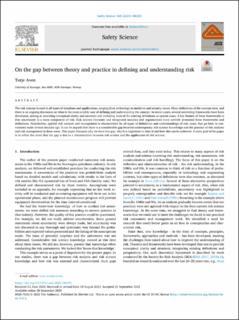| dc.contributor.author | Aven, Terje | |
| dc.date.accessioned | 2023-11-29T14:32:07Z | |
| dc.date.available | 2023-11-29T14:32:07Z | |
| dc.date.created | 2023-11-08T08:35:12Z | |
| dc.date.issued | 2023-09 | |
| dc.identifier.citation | Aven. T. (2023) On the gap between theory and practice in defining and understanding risk. Safety Science, 168, 106325. | en_US |
| dc.identifier.issn | 0925-7535 | |
| dc.identifier.uri | https://hdl.handle.net/11250/3105266 | |
| dc.description.abstract | The risk concept is used in all types of situations and applications, ranging from technology to medicine and security issues. Many definitions of the concept exist, and there is an ongoing discussion on what is the most suitable way of defining and understanding the concept. In recent years, several overriding frameworks have been developed, aiming at providing conceptual clarity and structure and including most of the existing definitions as special cases. A key feature of these frameworks is that uncertainty is a main component of risk. Risk science literature and recognized societies and organizations have actively promoted these frameworks and definitions. Nonetheless, applied risk analysis and management is characterized by all types of definitions and understandings of risk, many that go back to conventions made several decades ago. It can be argued that there is a considerable gap between contemporary risk science knowledge and the practice of risk analysis and risk management in these areas. This paper discusses why we have this gap, why it is important to close it and how this can be achieved. A main goal of the paper is to refute the claim that the gap is due to a disconnection between risk science and the application of risk science. | en_US |
| dc.language.iso | eng | en_US |
| dc.publisher | Elsevier Ltd. | en_US |
| dc.rights | Navngivelse-Ikkekommersiell 4.0 Internasjonal | * |
| dc.rights.uri | http://creativecommons.org/licenses/by-nc/4.0/deed.no | * |
| dc.subject | risikoanalyse | en_US |
| dc.subject | samfunnssikkerhet | en_US |
| dc.subject | risiko | en_US |
| dc.title | On the gap between theory and practice in defining and understanding risk | en_US |
| dc.type | Peer reviewed | en_US |
| dc.type | Journal article | en_US |
| dc.description.version | publishedVersion | en_US |
| dc.rights.holder | © 2023 The Author(s). | en_US |
| dc.subject.nsi | VDP::Samfunnsvitenskap: 200 | en_US |
| dc.source.volume | 168 | en_US |
| dc.source.journal | Safety Science | en_US |
| dc.identifier.doi | 10.1016/j.ssci.2023.106325 | |
| dc.identifier.cristin | 2193618 | |
| dc.source.articlenumber | 106325 | en_US |
| cristin.ispublished | true | |
| cristin.fulltext | original | |
| cristin.qualitycode | 2 | |

